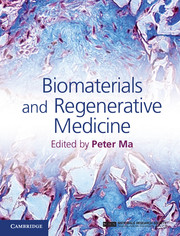Book contents
- Frontmatter
- Contents
- List of contributors
- Preface
- Part I Introduction to stem cells and regenerative medicine
- Part II Porous scaffolds for regenerative medicine
- Part III Hydrogel scaffolds for regenerative medicine
- Part IV Biological factor delivery
- Part V Animal models and clinical applications
- 25 Bone regeneration
- 26 Biomaterials for engineered tendon regeneration
- 27 Advancing articular cartilage repair through tissue engineering: from materials and cells to clinical translation
- 28 Engineering tissue-to-tissue interfaces
- 29 Models of composite bone and soft-tissue limb trauma
- 30 Tooth development and regeneration
- 31 Dentin–pulp tissue engineering and regeneration
- 32 Dental enamel regeneration
- 33 Hair follicle and skin regeneration
- 34 In-vitro blood vessel regeneration
- 35 Stem cells for vascular engineering
- 36 Cardiac tissue regeneration in bioreactors
- 37 Bladder regeneration
- Index
- References
30 - Tooth development and regeneration
from Part V - Animal models and clinical applications
Published online by Cambridge University Press: 05 February 2015
- Frontmatter
- Contents
- List of contributors
- Preface
- Part I Introduction to stem cells and regenerative medicine
- Part II Porous scaffolds for regenerative medicine
- Part III Hydrogel scaffolds for regenerative medicine
- Part IV Biological factor delivery
- Part V Animal models and clinical applications
- 25 Bone regeneration
- 26 Biomaterials for engineered tendon regeneration
- 27 Advancing articular cartilage repair through tissue engineering: from materials and cells to clinical translation
- 28 Engineering tissue-to-tissue interfaces
- 29 Models of composite bone and soft-tissue limb trauma
- 30 Tooth development and regeneration
- 31 Dentin–pulp tissue engineering and regeneration
- 32 Dental enamel regeneration
- 33 Hair follicle and skin regeneration
- 34 In-vitro blood vessel regeneration
- 35 Stem cells for vascular engineering
- 36 Cardiac tissue regeneration in bioreactors
- 37 Bladder regeneration
- Index
- References
Summary
Tooth development
Each tooth, even though it looks simple, is an organ with complex structure and consists of multiple types of tissues (Ten Cate, 1998). Dentin is the main component, which is a hard and avascular tissue with a small hollow tubular inside. Enamel is the hardest tissue of the whole living body, protecting the dentin underneath by covering the crown dentin. Cementum, including cellular and acellular cementum, is present on the surface of root dentin. Other than those three types of hard tissue, a tooth also contains dental pulp, the highly vascularized soft tissue that acts as nutrition source and biosensor, as well as periodontal ligament (PDL), the tissue with well-organized collagen bundles that anchors the tooth to the surrounding alveolar bone. Among those tissues, only enamel is from the epithelium. The rest of the dental tissues are all from the neural crest-cell-derived mesenchyme (Nanci, 2007). The sequential and reciprocal interactions between the oral epithelium and the cranial neural crest-derived mesenchyme are essential to control tooth formation, including their size, number, and shape (Thesleff and Nieminen, 1996).
- Type
- Chapter
- Information
- Biomaterials and Regenerative Medicine , pp. 555 - 569Publisher: Cambridge University PressPrint publication year: 2014



